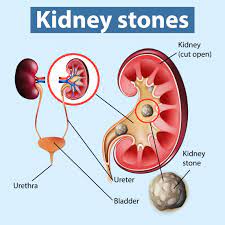
Post by Dr.Tejal Daftary and Dr. Sheetal Kantharia, Sep 27, 2023.
Renal Stone
Renal stone and homeopathy A kidney stone or stones are indicated by back or side pain, blood in the urine, and nausea or vomiting in addition to the pain. Although kidney stones typically range in size from a chickpea to a golf ball, they can also be as little as a grain of sand. Kidney stones: Prevelance Kidney stones are common across the world,around 12% of people affected all over India and around 1% of emergency cases of acute abdominal pain cases are because of renal colic and most of the time there are high chances of recurrence of kidney stones irrespective of treatment.
Renal stone and homeopathy
A kidney stone or stones are indicated by back or side pain, blood in the urine, and nausea or vomiting in addition to the pain. Although kidney stones typically range in size from a chickpea to a golf ball, they can also be as little as a grain of sand.
Kidney stones: Prevelance
Kidney stones are common across the world,around 12% of people affected all over India and around 1% of emergency cases of acute abdominal pain cases are because of renal colic and most of the time there are high chances of recurrence of kidney stones irrespective of treatment.
What is kidney stone?
Numerous dissolved minerals and salts are typically found in urine. You can develop stones if your urine contains a lot of these elements and salts.Kidney stones can start out small and enlarge over time, eventually filling the hollow interior of the kidney. Some kidney stones remain there and do not create any issues. The tube connecting the kidney to the bladder is called the ureter, and kidney stones can occasionally pass through it. Urine can carry the stone out of the body if it gets to the bladder. When a kidney stone lodges in the ureter, it limits the kidney's ability to excrete urine and cause pain.
You might not even be aware that you have a kidney stone (or stones), depending on their size. Even when tiny stones leave your body through your urinary tract, they can cause severe pain and even bleeding.
Causes
- Decrease urine output: not drinking enough water, working in hot place or exercising hard
- Eating a diet high in sodium, sugar, and protein.
- Family history of renal stone
- Obesity
- Sufferings with inflammatory bowel disorders.
- Recurrent urinary tract infections
- Medications such as diuretics,excessive calcium supplements.
Types Of Kidney Stones
Calcium oxalate: most common type ,inadequate dietary calcium and fluid intake may contribute to its formation
Uric acid: this type of kidney stone develop due to high acidic urine,a high purine rich diet may cause this stone,they are mostly genetic
Struvite stone: most common in women with repeated urinary tract infection
Cystine stone: rare type, cause of metabolic disorder. This type of stone start to form in childhood.
Symptoms
You can have kidney stone but may not even experience any kind of symptom, but when it start to move or become larger you may have symptoms which are:
- sharp, cramping pain in the back and side,
- Nausea and vomiting
- Blood in urine or cloudy urine with foul smell
- A feeling of intense need to urinate.
- Urinating more often or a burning feeling during urination.
- Fever and chills if there is infection.
Renal colic
When the kidney stone moves or get stuck in the uurinary tract you may experience severe pain in back or abdomen that is known as renal colic, usually the small stone will pass unnoticed it is the larger stone that cause more harm.
Renal colic comes in waves along with nausea and vomiting occasionally you will experience pain while urination or blood in urine.
Recurrent renal stone
Around 80% of people suffer from recurrent renal stone even after completing the treatment it is because of the lifestyle and dietary habits,medical condition such as primary hyperparathyroidism,obesity,diabetes and gout increase the risk of renal stone. Therefore it is important to manage this disease along with diet changes to prevent recurrence.
Prevention of Future Stone
- Drinking plenty of water
- Limit salt intake
- Lose weight
- Eat recommended amount of calcium
- Eat food with low oxalate level like Spinach,strawberries,tea, dried peas and beans,nuts
- Reduce animal protein.
Homeopathy in Renal stone
Homeopathy works beautifully in treatment of kidney stone and it can prevent most of the surgeries related to removal of kidney stones. As you know when stones are small(1 to 2mm) enough they will pass without creating any trouble and you may even not notice. But when stone gets stuck or its large( 3 to 7 mm)it will create extreme pain that’s where homeopathy will help. Homeopathy treatment works on following points
- It removes the stone by decreasing its size or breaking it into smaller pieces
- It will help with symptoms such as pain, blood in urine.
- It will reduce the tendency of recurrent stone formation
